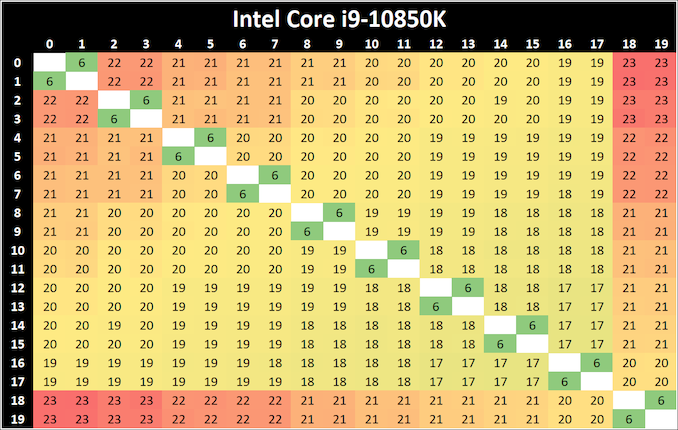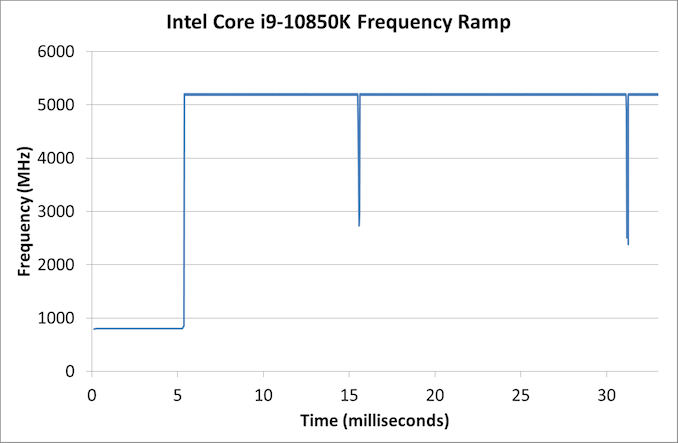Intel Core i9-10850K Review: The Real Intel Flagship
by Dr. Ian Cutress on January 4, 2021 9:00 AM EST- Posted in
- CPUs
- Intel
- Core
- Z490
- 10th Gen Core
- Comet Lake
- LGA1200
- i9-10850K
CPU Tests: Microbenchmarks
Core-to-Core Latency
As the core count of modern CPUs is growing, we are reaching a time when the time to access each core from a different core is no longer a constant. Even before the advent of heterogeneous SoC designs, processors built on large rings or meshes can have different latencies to access the nearest core compared to the furthest core. This rings true especially in multi-socket server environments.
But modern CPUs, even desktop and consumer CPUs, can have variable access latency to get to another core. For example, in the first generation Threadripper CPUs, we had four chips on the package, each with 8 threads, and each with a different core-to-core latency depending on if it was on-die or off-die. This gets more complex with products like Lakefield, which has two different communication buses depending on which core is talking to which.
If you are a regular reader of AnandTech’s CPU reviews, you will recognize our Core-to-Core latency test. It’s a great way to show exactly how groups of cores are laid out on the silicon. This is a custom in-house test built by Andrei, and we know there are competing tests out there, but we feel ours is the most accurate to how quick an access between two cores can happen.
When we first reviewed the 10-core Comet Lake processors, we noticed that a core (or two) seemed to take slightly longer to ping/pong than the others. We see the same pattern here again with the final core.
Frequency Ramping
Both AMD and Intel over the past few years have introduced features to their processors that speed up the time from when a CPU moves from idle into a high powered state. The effect of this means that users can get peak performance quicker, but the biggest knock-on effect for this is with battery life in mobile devices, especially if a system can turbo up quick and turbo down quick, ensuring that it stays in the lowest and most efficient power state for as long as possible.
Intel’s technology is called SpeedShift, although SpeedShift was not enabled until Skylake.
One of the issues though with this technology is that sometimes the adjustments in frequency can be so fast, software cannot detect them. If the frequency is changing on the order of microseconds, but your software is only probing frequency in milliseconds (or seconds), then quick changes will be missed. Not only that, as an observer probing the frequency, you could be affecting the actual turbo performance. When the CPU is changing frequency, it essentially has to pause all compute while it aligns the frequency rate of the whole core.
We wrote an extensive review analysis piece on this, called ‘Reaching for Turbo: Aligning Perception with AMD’s Frequency Metrics’, due to an issue where users were not observing the peak turbo speeds for AMD’s processors.
We got around the issue by making the frequency probing the workload causing the turbo. The software is able to detect frequency adjustments on a microsecond scale, so we can see how well a system can get to those boost frequencies. Our Frequency Ramp tool has already been in use in a number of reviews.
The Core i9-10850K ramps up extremely quickly from idle to peak turbo, in the region of about 5 milliseconds. This is faster than the 16 ms we typically observe.












126 Comments
View All Comments
temps - Tuesday, January 5, 2021 - link
Sorry but most of us professionals have moved to Thunderbolt interfaces. How can Ryzen outperform Intel at something it can't support?Qasar - Tuesday, January 5, 2021 - link
so because ryzen doesnt support thunderbolt, the whole platform is slower? thats just stupidtemps - Wednesday, January 6, 2021 - link
I said "outperform" not "slower." Besides, when I built my PC the only AMD that actually was faster than it was the 3900X, which you couldn't buy anywhere at the time. In fact, I still can't get one locally.Zoolook - Wednesday, January 6, 2021 - link
You seem pretty ignorant, there are plenty of am4 motherboards with thunderbolt support.temps - Wednesday, January 6, 2021 - link
What a joke, I can find exactly one officially certified AM4 motherboard and it's mini ITX. Again, we need these for work. I'm not going to run an uncertified, unsupported setup.Qasar - Wednesday, January 6, 2021 - link
zoolook is right, temps, you do seem pretty ignorant if you think just because intel has thunderbolt, it out performs amd, but you dont say how. thunderbolt has nothing to do with how fast a comp is, its a connection interface for external devices, like usb.temps - Wednesday, January 6, 2021 - link
I already said my audio interface needs Thunderbolt... so really, a Celeron outperforms AMD for my requirements. Good job reading. Good day.TheinsanegamerN - Tuesday, January 5, 2021 - link
They did, they were called HDET, and you whined they were too expensive.eastcoast_pete - Monday, January 4, 2021 - link
Thanks and Happy New Year! @Ian and all, one question I had for a while is why Intel or AMD don't use the approach that Qualcomm (with help from ARM and TSMC) started with their 865 SoC? AFAIK, they specifically designed and made one of the four big cores as the core with the highest performance and frequency, and the 888 and others are now using that approach even more formalized by having a single X1 core alongside the 3 A78 big cores. So, is an approach like this - one dedicated high frequency, larger cache etc core plus 5, 7 and 15 others- possible and feasible in x86/x64 CPUs, and if so, why isn't it used? Thanks!Otritus - Monday, January 4, 2021 - link
The windows scheduler was not good enough to properly allocate workloads to the best cores, losing out on performance and efficiency. Intel believes that the scheduler will be good enough when they launch their 12th gen CPUs using Golden Cove and Gracemont cores.